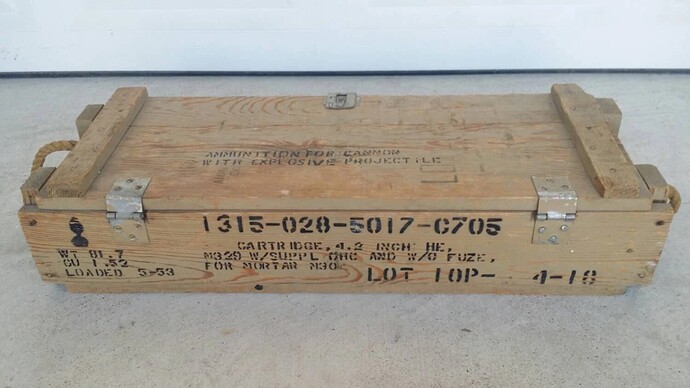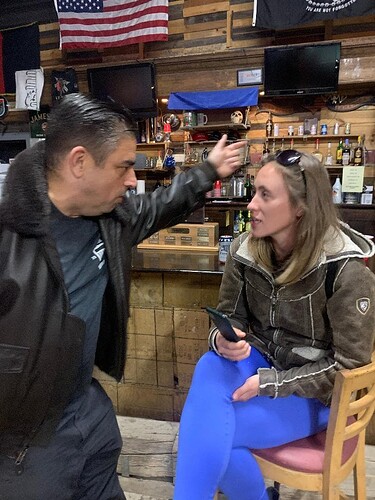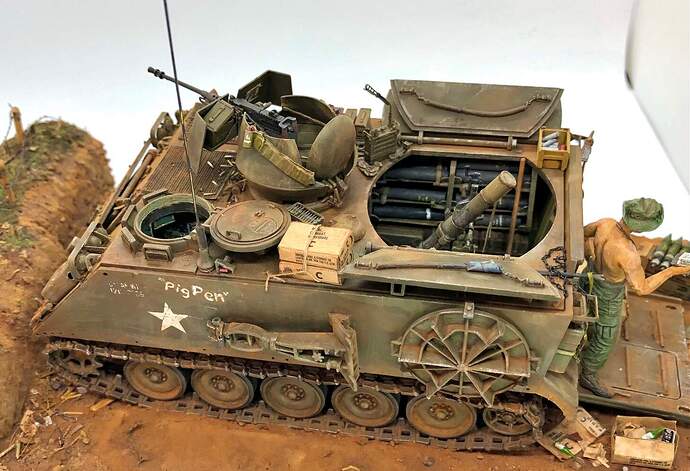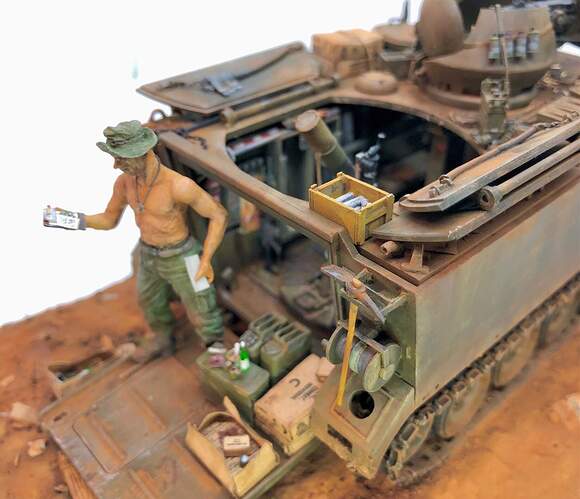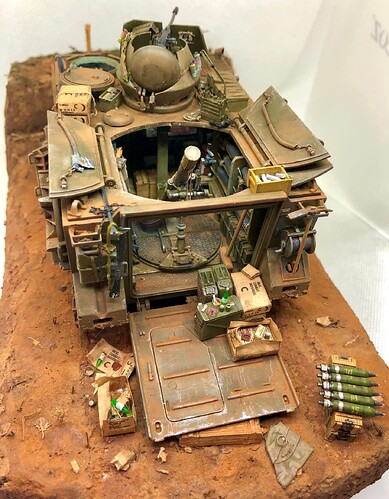Thanks SableLiger! This is exactly the markings on the shipping container I was looking for. If you own this, would you mind telling me what the markings on the tube say? I am going to have to make my own decals for this project.
Thanks Gary. What do you think about the lack of boxes and tubes around the carriers
Thank you to everyone who replied. French and ptruhe, those pictures you posted were right on spot with the views I was looking for.
No; all images were on the net, but the fiber tubes would read the same way as this shipping crate.
CARTRIDGE, 4.2 INCH HE
M329 W/SUPPL OHC AND W/O FUZE
LOT IOP-4-18
Perfect!
probably means some enterprising fellow building a bunker grabbed them and filled them with dirt. Out west, our four duce rounds came in in pre opened boxes. Fused or not I don’t remember as I usually stayed away from those tubes or you’d be put to work. 105 rounds usually came out in nets, and have seen them loose and also in wood boxes. 155 rounds always came out on pallets (8" and 175mm too).
Remember a box with two 4.2" rounds in it isn’t all that heavy, but also awkward for one guy (like me anyway). On the otherhand that same box filled with dirt is as good as a dozen sand bags with less work. I’ve seen huge piles of brass canisters and the tubes, but never gave them much thought. It wasn’t my job to worry about that stuff, and there were guys back in the rear that slept on dry warm mattresses that got that job.
A mortar track would probably be resupplied via a net load, and the boxes would be used or burnt. CAV units move daily from place to place, so they have little need for the boxes except to store personal junk. Bomb fuse canisters were far more popular for that job. Every body coveted them, but I had the pistol belts and helmets to move to first in line.
gary
Ammo boxes also make a good bar. This is the MC bar in Florence. The gal is a Ukrainian refugee.
I should have taken a photo of the meeting table tonight. It’s perched on boxes more like in the above photo. You can swing out a panel and sleep in a cot inside the boxes, totally unseen.
I loved building my Vietnam M106. Used mostly the Verlinden book as reference. I wasn’t a member here at the time to get all the great advice from this forum.
This tube uses an AIC (R4OF_; used 1942 to approx 1962) rather than the DODAC used later. I mention this because there were several notable changes for later ammunition:
- The nomenclature went from SHELL to CARTRIDGE.
- Rounds could be shipped fuzed or unfuzed.
- Smoke rounds went from light gray with yellow band and markings to light green with yellow band and red markings.
- Smoke round burster composition went from tetrytol to Comp B.
These markings will be reflected on the tube’s text, text colors, and closing tape color.
I think the N335 is not the metal box designation but the DODAC for the fuze itself. The M557 PD fuze has a DODAC of 1390-N335. These were packed 8 to a metal box with two boxes in a wire-bound box. One document I have says a similar fuze is packed in M2A1 metal boxes, which are the familiar “50 cal cans”.
A common loading for M557 fuzes was with M329A1 HE cartridges. In 1969 these cartridges were prepared as a “jungle wrap” and packed into M251 or M251A1 fiber tubes. I’d hazard a guess that if the cartridges were packed with fuzes there would not be any fuze boxes in the vehicle. It’s possible that separate VT fuzes could be issued for change out before firing, I guess.
It looks like the common loading of the M328A1 was also with the M557 fuze, in the M251 container. There is no reference to a “jungle wrap” in the 1965 document. (I suspect it was a bag over the fiber tube.)
Hope that helps,
KL
Sooo, what exactly goes in the fuse rack on the left side? Fuses in tubes, bare fuses, c-rats?
Shooting a WP round with a time fuze is actually against the Geneva Convention.
I can see you’ve never played the survival game. Remember it’s Dodge city out there, and when somebody wants aerial burst anything; he gets it without a second thought! Then when your butt’s in a sling he comes to your aid without a second thought. I can just see a 20 year old kid wanting nothing but to get out of the holes he’s dug, and calling in WP about two hundred feet out front of him and you saying NO! After Top got done with your head; it’d get real ugly
gary
No, it is not. It definitely is not. For several reasons:
- The Geneva Conventions primarily deal with the “Victims of Armed Conflicts”. They do not cover the conduct of war.
- The Hague conventions covering the “Methods and Means of Warfare” do not mention incendiary weapons.
- The use of incendiary weapons is addressed by the Convention on Certain Conventional Weapons, Protocol III. (CCW III)
- CCW III specifically excludes smoke projectiles from the Protocol. WP rounds are not incendiaries but smoke rounds with a secondary or additional incendiary effect.
- CCW III is silent on any functional aspect of incendiary weapons such as fuzing.
- CCW III prohibits the use of incendiary weapons against civilians. There is no prohibition against the use of incendiary weapons against exclusively military targets.
Recent uses of WP rounds by Russian forces in Ukraine are arguably war crimes because they are being used against civilians, or indiscriminately against civilian areas and military targets interspersed with civilians. In fact, the use of high-explosive or even solid, inert ammunition in the same ways would also be a war crimes. Conflict parties must make honest efforts to protect civilians, regardless of the weapon. That is the issue.
The legislation on conventional weapons almost always boils down to this:
- Use against civilians or indiscriminately in civilian areas - Prohibited.
- Use against specific military targets - Not Prohibited.
There are some items that are categorically banned, but even the bans include exceptions and provisos that may still permit the use of those items.
One must be skeptical of claims along the lines of “They are using banned weapons! That’s a war crime!” Usually the people talking are greatly uninformed and unconcerned with facts. A reasonable examination of the such cases may indicate that a crime has occurred but it is likely the circumstances of a weapon’s use that are unlawful, not the weapon itself.
KL
![]()
![]()
![]()
![]() Oh my.
Oh my.
Another one off the rails.
I love the detail on the gun track. Are the markings on the mortar rounds decals? The weathering on the vehicle is perfect.
You are half wrong. The Generva Conventions are more properly called ‘The Laws of Armed Conflict’ and absolutely, unquestionably form the core of international humanitarian law, which regulates the conduct of armed conflict and seeks to limit its effects. By doing so, they protect people not taking part in hostilities and those who are no longer doing so.
I didn’t say “Victims of Armed Conflicts” was an official name, it’s just a categorization of its effect. Yes, it attempts to control the conduct of warfare in the broad sense, but it does not relate to the “Methods and Means” aspects under discussion here.
KL
But you quite clearly stated that the Geneva Conventions do not cover the conduct of war.
They demonstrably do.
Helllooooooo
Topic is Help with M106A1 mortar carrier. Can we keep the dialog in that lane?
Keeping the Topic on track would be the business of the Topic’s Author.
